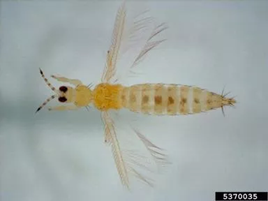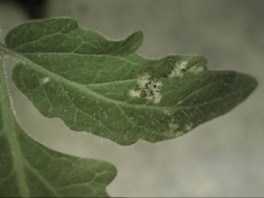Western Flower Thrip

This week, we are talking about Western Flower Thrips (Frankliniella occidentalis), partly due to the virus that was our question of the week. Thrips are a group of tiny, elongated, and fringe-winged insects that are commonly found in flowers of most plants. Many feed on plant tissues as well as pollen. They feed by a “punch and suck” method, whereby they push their mouth cone into plant tissue or pollen, and then suck the contents through their straw-like stylets. A few species of thrips are now worldwide pests, one of which is the western flower thrips (Frankliniella occidentalis). In this region, western flower thrips damage apples and many horticultural and field crops, such as tomatoes and cotton. Some species of thrips can be pests of houseplants as well.
Adult western flower thrips can be distinguished from other insects by their fringed wings, tubular body shape, and color. Females are about 1/25 of an inch long and have many color forms. These vary from pale yellow thorax and abdomen to yellow thorax and dark abdomen to very dark color throughout their body. In higher elevations, females are black. Wings are fringed on the margins and are clear to yellow. Males are smaller than females (about 2/3 the female length) and are light yellow throughout their bodies. Wings are clear and yellow like those of the female. Larvae are about 1/50 inch long and 1/75 inch wide, translucent white to yellow, and tubular. They can be mistaken for leafhoppers and Campylomma nymphs, which are about the same size and color. However, thrips larvae are more elongated and worm-like.
Controlling the Western Flower Thrips is particularly challenging because of its biological characteristics. Eggs are deposited directly into an infected plant, making them inaccessible. After this, they undergo two larval stages, where larvae generally remain in the flower bud or foliage, where they can be well-protected from contact insecticides and many natural enemies. After the second larval stage, the pest moves to the soil and pupates. While in the soil, they do not feed and are again protected from insecticides aimed at the foliage (weed or crop). When the adults emerge with wings, they feed primarily on the flowers and terminal buds. Pesticide resistance is a documented problem with controlling trips chemically. The first step is to monitor for thrips using yellow or blue sticky cards placed at 1-3/100 ft2 density. Consider using a trap crop for thrips and an indicator plant for TSWV. The trap crop, such as fava bean and petunia, is attractive to thrips and will alert you to their presence. Petunia cultivars ‘Calypso’, ‘Summer Madness’, and ‘Super Blue Magic’ have been reported to be particularly attractive. Indicator plants may show TSWV symptoms earlier than some other susceptible crops, letting you know there is an outbreak of the virus. Both petunia and gloxinia have been reported to develop lesions 2-3 days after feeding by infected thrips. Adding non-adhesive yellow boards behind petunia (at plant height) may increase their attractiveness to thrips. Apply an insecticide when there is a sudden increase in the thrip population on sticky cards, and >five thrips/trap/week are present. Do not wait until numbers are high. Continue insecticide applications at 5-day intervals until numbers decline to less than 5 per trap. Look for chemicals with the active ingredients of bifenthrin, cyfluthrin, horticultural oils, acephate, or Spinosad. I would recommend rotating chemicals to reduce the chances that the insects will become resistant to the products that you are using. Chemical resistance has been documented in several populations of thrips across the country.
characteristics. Eggs are deposited directly into an infected plant, making them inaccessible. After this, they undergo two larval stages, where larvae generally remain in the flower bud or foliage, where they can be well-protected from contact insecticides and many natural enemies. After the second larval stage, the pest moves to the soil and pupates. While in the soil, they do not feed and are again protected from insecticides aimed at the foliage (weed or crop). When the adults emerge with wings, they feed primarily on the flowers and terminal buds. Pesticide resistance is a documented problem with controlling trips chemically. The first step is to monitor for thrips using yellow or blue sticky cards placed at 1-3/100 ft2 density. Consider using a trap crop for thrips and an indicator plant for TSWV. The trap crop, such as fava bean and petunia, is attractive to thrips and will alert you to their presence. Petunia cultivars ‘Calypso’, ‘Summer Madness’, and ‘Super Blue Magic’ have been reported to be particularly attractive. Indicator plants may show TSWV symptoms earlier than some other susceptible crops, letting you know there is an outbreak of the virus. Both petunia and gloxinia have been reported to develop lesions 2-3 days after feeding by infected thrips. Adding non-adhesive yellow boards behind petunia (at plant height) may increase their attractiveness to thrips. Apply an insecticide when there is a sudden increase in the thrip population on sticky cards, and >five thrips/trap/week are present. Do not wait until numbers are high. Continue insecticide applications at 5-day intervals until numbers decline to less than 5 per trap. Look for chemicals with the active ingredients of bifenthrin, cyfluthrin, horticultural oils, acephate, or Spinosad. I would recommend rotating chemicals to reduce the chances that the insects will become resistant to the products that you are using. Chemical resistance has been documented in several populations of thrips across the country.

Have questions? Contact our office where our Horticulture Extension Agent will assist you with questions.
Phone: (316) 321-9660
Email: callae@ksu.edu